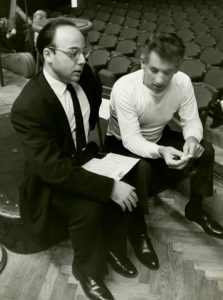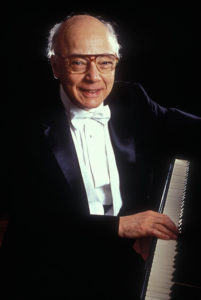Seymour Lipkin (1927-2015) spent six years in Serkin’s class at the Curtis Institute, including two along with Istomin. In 1948, Lipkin won the Rachmaninoff Prize, which was presented to him by Mrs. Rachmaninoff and Vladimir Horowitz. It launched his career in a spectacular manner, but he soon gave priority to conducting. He had studied with Koussevitsky and later became the assistant to George Szell and Leonard Bernstein. For nearly twenty years he was music director of the Long Island Symphony Orchestra and the Joffrey Ballet, one of the most important American dance companies.
In 1969, Seymour Lipkin accepted Serkin’s offer to come and teach at Curtis. In 1979 he gave up conducting and devoted himself once again to the piano, alternating between teaching (from 1986, he also taught at the Juilliard School), running the Kneissel Hall Chamber Music Festival and School, and pursuing his career as a pianist. From 2004, he recorded the complete Beethoven and Schubert sonatas.
Istomin and Lipkin remained friends for more than sixty years. In 2001, when Istomin spoke about Lipkin to his biographer James Gollin, he described him as “a good guy and a wonderful musician”. In addition to sharing the legacy of Serkin, they had many common interests: an admiration for Toscanini and Heifetz, a deep veneration for Stravinsky, and a passion for chamber music. When Istomin decided to resign as director of the Kapell Competition and the University of Maryland Piano Festival, he thought that Seymour Lipkin would be the most suitable replacement. Indeed, Lipkin succeeded him until 1992. .
Seymour Lipkin was a supportive figure during many highlights in Istomin’s career, even at the Prades Festival in 1950. For his part, Istomin generously agreed to play the Emperor Concerto under his direction with the Long Island Symphony Orchestra for three gala concerts in November 1976.
On that occasion, a journalist interviewed Lipkin, and described his friend Istomin to him as being a very reserved person, with a quite stiff demeanor, who invariably spoke in a calm and measured voice. Seymour Lipkin found this amusing, and replied that these appearances actually concealed “a very poetic soul”. For Istomin’s 75th birthday, Lipkin wrote to him: “I remember how much I admired the idealism and high standards you had brought to the Kapell Competition, when I had the good fortune to succeed you there. Many other things remain in my head: the beauty and excitement of your debut performance of the Brahms B flat with the New York Philharmonic; some particularly beautifully sculpted phrases in Brahms G minor Quartet…”
After Istomin’s death, Seymour Lipkin personally undertook the task of transferring the acetate 78-rpm recording of Istomin’s debut with the New York Philharmonic in Brahms’ Second Concerto under Rodzinski to CD, and offered it to Marta Istomin after the death of her husband in a characteristic gesture of kindness and generosity.
Documents
Beethoven. 32 Variations in C minor. Seymour Lipkin. (recording proposed by www.hdclassicalmusic.com.)
Audio Player.
Interview on April 13, 2013.



